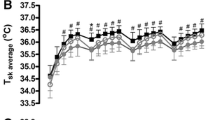Summary
Thermal balance was studied in 11 boys, aged 10–12 years, with various values for maximal oxygen uptake (\(\dot V_{O_{2 max} } \)), during two standardized sweating tests performed in a climatic chamber in randomized order. One of the tests consisted in a 90-min passive heat exposure [dry bulb temperature (T db) 45° C] at rest. The second test was represented by a 60-min ergocycle exercise at 60% of individual\(\dot V_{O_{2 max} } \) (T db 20° C). At rest, rectal temperature increased during heat exposure similar to observations made in adults, but the combined heat transfer coefficient reached higher values, reflecting greater radiative and convective heat gains in the children. Children also exhibited a greater increase in mean skin temperature, and a greater heat dissipation through sweating. Conversely, during the exercise sweating-test, although the increase in rectal temperature did not differ from that of adults for similar levels of exercise, evaporative heat loss was much lower in children, suggesting a greater radiative and convective heat loss due to the relatively greater body surface area. Thermophysiological reactions were not related to\(\dot V_{O_{2 max} } \) in children, in contrast to adults.
Similar content being viewed by others
References
Araki T, Toda Y, Inoue Y, Tsujino A (1979) Age differences in sweating during muscular exercise. J Phys Fitness Jpn 28:239–248
Araki T, Mitsushita K, Umeno K, Tsujino A, Toda Y (1981) Effects of physical training on exercise induced sweating in women. J Appl Physiol 51:1526–1532
Astrand PO (1952) Experimental studies of physical working capacity in relation to sex and age. Munskgaard, Copenhagen
Bar-Or O (1980) Climate and the exercising child — a review. Int J Sports Med 1:53–65
Bittel J, Henane R (1975) Comparison of neutral exchanges in men and women under neutral and hot conditions. J Physiol (London) 250:475–489
Cohen J, Gisolfi CV (1982) Effects of interval training on workheat tolerance of young women. Med Sci Sports 14:46–52
Colin J, Timbal J, Houdas Y, Boutelier C, Guieu JD (1971) Computation of mean temperature from rectal and skin temperature. J Appl Physiol 31:484–489
Davies CTM (1981) Thermal responses to exercise in children. Ergonomics 48:55–61
Drinkwater BL, Horvath SM (1979) Heat tolerance and aging. Med Sci Sports 11:49–55
Drinkwater BL, Kupprat IC, Denton JE, Crist JL, Horvath SM (1977) Response of prepubertal girls and college women to work in the heat. J Appl Physiol 43:1046–1053
Eriksson BO, Karlsson J, Saltin B (1971) Muscle metabolites during exercise in pubertal boys. Acta Paediatr Scand [Suppl] 217:154–157
Flandrois R, Grandmontagne M, Mayet MH, Favier R, Frutoso J (1982) La consommation maximale d'oxygène chez le jeune Frangais, sa variation avec l'âge, le sexe, l'entraînement. J Physiol (Paris) 78:186–194
Haralambie G (1979) Skeletal muscle enzyme activities in female subjects of various ages. Bull Eur Physiopathol Respir 15:259–268
Haymes EM, McGormick RJ, Buskirk ER (1975) Heat tolerance of exercising lean and obese prepubertal boys. J Appl Physiol 39:457–461
Henane R, Valatx JL (1973) Thermoregulatory changes induced during heat acclimatization by controlled hyperthermia in man. J Physiol (London) 230:255–271
Henane R, Flandrois R, Charbonnier JP (1977) Increase in sweating sensitivity by endurance conditioning in man. J Appl Physiol 43:822–828
Kobayashi Y, Ando Y, Okuda N, Takaba S, Ohara K (1980) Effects of endurance training on thermoregulation in females. Med Sci Sports 12:361–364
Macek M, Vavra J (1971) Cardiopulmonary and metabolic changes during exercise in children 6–14 years old. J Appl Physiol 30:202–204
Roberts MF, Wenger CB, Stolwijk JAJ, Nadel ER (1977) Skin blood flow and sweating changes following exercise and heat acclimatization. J Appl Physiol 43:133–137
Rowland TW, Montis PP (1985) Organizing road races for children: special concerns. Phys Sports Med 13:126–132
Saltin B, Hermansen L (1966) Esophageal, rectal, and muscle temperature during exercise. J Appl Physiol 21:1757–1762
Sato K, Sato F (1983) Individual variations in structure and function of human eccrine sweat glands. Am J Physiol 245: R203-R208
Schvartz E, Bhattacharya A, Sperinde SJ, Brock PJ, Sciaraffa D (1979) Sweating response during heat acclimation and moderate conditioning. J Appl Physiol 46:676–680
Taylor NAS (1986) Eccrine sweat glands. Adaptations to physical training and heat acclimation. Sports Med 3:387–397
Wagner JA, Robinson S, Marino RP (1974) Age and temperature regulation of humans in neutral and cold environments. J Appl Physiol 37:562–565
Author information
Authors and Affiliations
Rights and permissions
About this article
Cite this article
Delamarche, P., Bittel, J., Lacour, J.R. et al. Thermoregulation at rest and during exercise in prepubertal boys. Europ. J. Appl. Physiol. 60, 436–440 (1990). https://doi.org/10.1007/BF00705033
Accepted:
Issue Date:
DOI: https://doi.org/10.1007/BF00705033




